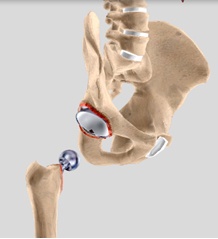Revision Hip Replacement
Revision hip replacement is a surgical procedure performed in individuals who already had hip replacement surgery but had certain complications that led to failure of the previous surgery. Total hip replacement is recommended in certain disease conditions of hip joint and hip arthritis is one of those common conditions. Total hip replacement surgery is an option to relieve severe arthritis pain that limits your daily activities. Some replacement will last longer, while other hip replacement implants can fail due to various reasons and may need to be replaced. When implant failure occurs another surgery may be needed to replace the failed implant, known as revision hip replacement surgery.
In revision hip replacement all or part of previously implanted hip-joint is replaced with a new artificial hip-joint. When a replacement joint wears out, loosens or develops a problem, it can be replaced in a revision hip replacement surgery.
Revision hip replacement is recommended in patients with:
- Increasing pain in the affected hip is one of the first indications that revision surgery is necessary.
- Plastic (polyethylene) wear in which the plastic implant is changed
- Dislocation of previous implants
- Loosening of the hip joint prostheses
- Infection of the hip replacement
- Weakening of bone around the hip replacement (osteolysis)
Procedure

In revision hip replacement surgery, your surgeon removes the old plastic liner and the metal socket from the acetabulum. The acetabulum is prepared using wire mesh to make up for the socket space. Then the new metal shell is inserted into the socket using screws or special cement. A liner made of plastic, ceramic or metal is placed inside the metal socket. To prepare the femoral component, the top of the femur is cut into several pieces to remove the implant. The segments of bone are cleaned and the new femoral implant is inserted into the femur either by a press fit or using bone cement. The segments of the femur are held in place with surgical wire. Then the femoral head component made of metal or ceramic is placed on the femoral stem. All the new parts are secured in place to form the new hip joint. The muscles and tendons around the new joint are repaired and the incision is closed.
After undergoing total hip replacement, you must take special care to prevent the new joint from dislocating and to ensure proper healing.
- Total Hip Replacement
- Minimally invasive anterior hip replacement


